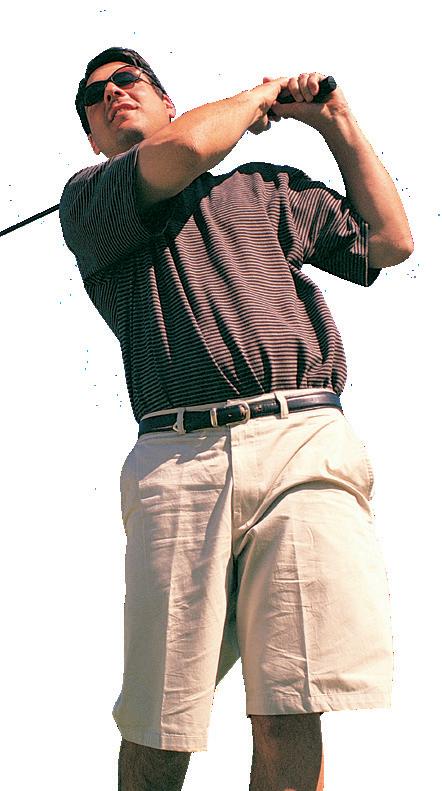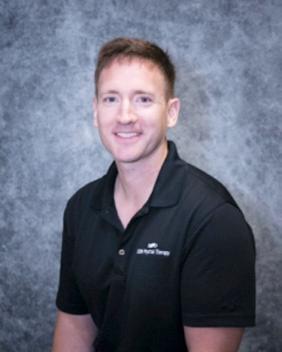
7 minute read
GOLF WELLNESS
WITH
Stretch Then Swing
Learn from SSM’s Titleist Performance Institute trained Physical Therapist
e have all heard the old adage “you are what you eat,” which refers to the nutrients that you put into your body dictate your overall health, function andW performance in any activity. Similarly, one could say “you are how you train,” too.
The way you move is important. Allowing your body to move in the correct manner will not only decrease your chances of injuries while competing in your favorite recreational activity, but it will also allow you to move in a pain free manner with all your daily activities.
Rotational athletes are constantly moving their bodies through high velocity motions causing increased stress on tissues which can increase strain on the body. Whether your choice of sport is baseball, volleyball, or even cricket, if your body is not moving in an optimal manner, injury is bound to happen.
Golfers are no exception. Whether you are a novice, weekend warrior or professional linkster, golfers undergo some of the quickest changes in body movement of any sport, and that precision of movement is key in preventing injuries. Our bodies are comprised of a system of joints that are either considered a stable joint or a mobile joint. When we confuse the two systems and change a stable joint into a mobile joint, injuries occur. For golfers, low back injuries are prevalent due to the simple fact that we are changing a stable joint (lumbar spine) into a mobile joint do to improper conditioning and stretching. The good news is that can be changed, and injuries can be prevented if we only take the time to stretch.
By training your body in the proper manner, you can learn to not only swing your golf club pain free, but you can improve your overall mechanics allowing you to hit your ball farther, and without that wicked slice. Stretching is a key component in any sport and in life that is often overlooked. By allowing your body to stretch certain muscle groups, you are permitting for better and improved movement, especially as it pertains to your golf swing. In order to perform your best on and off the links you have to incorporate stretching into your daily regiment starting from the tips of your toes, to the top of your head. Low back spasms, neck strains, and shoulder injuries can all be lessened or even avoided if you just take the time to stretch properly before your next round.
When it comes to stretching and golf, there is no shortage of exercises that you can complete to improve your performance. Golfers entire bodies are constantly under stress from back swing to follow through, and if you neglect stretching each body segment, break down will occur. If you are some one that suffers from mobility restrictions due to tight muscles, this could affect your game from the instant when you first address your ball. The good news is that physical therapy and improving your overall mobility can help. Below are body regions that are important to stretch before your next round in order to avoid injuries with advice on exercises that you can complete to enhance your game.
Neck
The neck is a vulnerable body part when it comes to the golf swing and can be the source of some tissue strains if there is restriction in movement. If you lack proper cervical flex and rotation, not only can that lead to injury, but also a poor golf shot. To ensure you have proper mobility and range of motion, make sure prior to your next round you complete some cervical flexion and rotation stretches. It is as simple as curling your chin to your chest in a controlled manner until you feel a slight stretch in the back of your neck, and then rotate your head side to side slowly in small motions. This will help to loosen up your cervical extensor muscles in order to minimize stress, and to allow you to keep focus on the ball during your swing.

Shoulders
When a golfer lacks mobility in the shoulder girdle, this can lead to multiple poor swing characteristics, and shoulder pain. A golfer needs good shoulder external and internal rotation bilaterally in order to ensure a fluid backswing and follow through in order to not compromise both the labrum and rotator cuff. A stretch that can be completed prior to your swing is the standing prayers stretch. Take your golf club and place it in front of you with both hands on top of the handle with the club head on the ground, and then lean backwards while hinging at your waist until you feel a comfortable stretch across your shoulders. Some players will also feel a stretch across their lumbar spine, so don’t be surprised!


Hips Thoracic & Lumbar Spine
Just like the shoulders, the hips are meant to move freely in three different planes and ensuring you have enough mobility through the hips will allow you to move more efficiently with golfing. In order to improve your swing and mechanics with golf, hip internal and external rotation are important as it pertains to both the backswing and follow through. If you do not have enough mobility in your hips, you will pull off early from hitting the ball causing many faulty swing mechanics. Stretching your hip girdle will allow you to address the ball better in all phases of the golf swing and will help you strike the ball straight each time.
An easy stretch to complete in order to improve hip mobility is while standing just complete small circles with a straight leg in a clockwise and counter clockwise motion.
Low back strain, and other injuries are very common amongst golfers do to the simple fact that they lack the stability in the lumbar spine causing that region to move more than it is designed. The thoracic spine is a highly mobile joint in which one of its main motions is rotation. When golfing, no matter what phase of your swing, your thoracic spine is one of your main forces for rotation; however, too many golfers learn to rotate through their lumbar spine due to decreased overall core stability, or just having poor mobility along their thoracic spine do to improper training, or just through your daily activities.
The exercise below addresses both concepts: the ability to retrain your body to rotate through the thoracic spine, while keep your lower abdominals engaged thus creating a stable base along the lumbar spine preventing excessive rotation. This is my favorite stretch to not only complete, but to educate golfers on how to properly move in order to minimize injury, and to improve overall mechanics with your swing.
Not only will this open book stretch help with thoracic mobility, but also shoulder mobility. Learning to rotate more through your thoracic spine, and improving core stability will decrease back injuries, and strain along other regions of the body.
You start by laying on your side with your arm straight in front of you. Keep your eyes on your hand and then allow your chest to open while lifting your arm to your side, while keeping your abs tight. You will feel a stretch in your middle back, and your low back should be stable with no pain. G olf is an amazing sport, but in order to compete at whatever level you choose pain free, one has to learn to move correctly. Everything in life is based on movement. Whether it is individual cells in our body, or how we swing a golf club, moving precisely and correctly will not only help you gain a few yards off your drive, but will ensure the ability to decrease stress on your body when playing your next round allowing you to avoid injuries. So next time when you find yourself on that golf course remember these little words, “Stretch Then Swing.” Take that extra time and complete a few stretches to improve your overall mechanics, and maybe even add a few more yards onto your drive by minimizing that slice for you have learned how to move more efficiently and effectively.



Kristopher Gordon is an SSM Health Physical Therapist located in Belleville, Ill. He specializes in treatment of golf injuries and is Titleist Performance Institute Medical 2 Certified. To make an appointment to see Kristopher or another SSM Health physical therapist visit ssmphysicaltherapy.com/ contact/find-a-location










